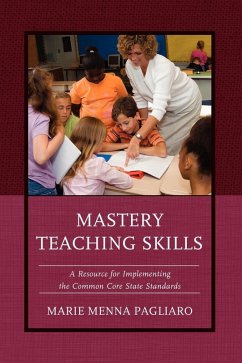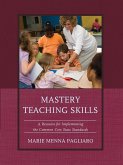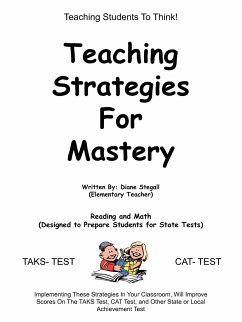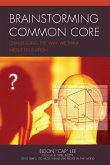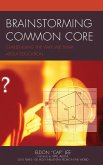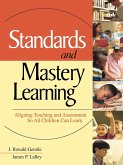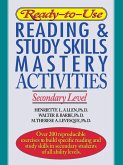Marie Menna Pagliaro
Mastery Teaching Skills
A Resource for Implementing the Common Core State Standards
Marie Menna Pagliaro
Mastery Teaching Skills
A Resource for Implementing the Common Core State Standards
- Gebundenes Buch
- Merkliste
- Auf die Merkliste
- Bewerten Bewerten
- Teilen
- Produkt teilen
- Produkterinnerung
- Produkterinnerung
Mastery Teaching Skills is a professional development book that will help teachers and principals implement the Common Core State Standards. This book will help you to achieve a comprehensive set of pedagogical skills to deliver successfully the Common Core Standards.
Andere Kunden interessierten sich auch für
![Mastery Teaching Skills Mastery Teaching Skills]() Marie Menna PagliaroMastery Teaching Skills44,99 €
Marie Menna PagliaroMastery Teaching Skills44,99 €![Teaching Strategies for Mastery Teaching Strategies for Mastery]() Diane StegallTeaching Strategies for Mastery17,99 €
Diane StegallTeaching Strategies for Mastery17,99 €![Mastery Of Excellent Teaching Mastery Of Excellent Teaching]() Harminder GillMastery Of Excellent Teaching31,99 €
Harminder GillMastery Of Excellent Teaching31,99 €![Brainstorming Common Core Brainstorming Common Core]() Eldon "Cap" LeeBrainstorming Common Core60,99 €
Eldon "Cap" LeeBrainstorming Common Core60,99 €![Brainstorming Common Core Brainstorming Common Core]() Eldon "Cap" LeeBrainstorming Common Core105,99 €
Eldon "Cap" LeeBrainstorming Common Core105,99 €![Standards and Mastery Learning Standards and Mastery Learning]() J. Ronald GentileStandards and Mastery Learning40,99 €
J. Ronald GentileStandards and Mastery Learning40,99 €![Ready-To-Use Reading & Study Skills Mastery Activities Ready-To-Use Reading & Study Skills Mastery Activities]() Henriette L AllenReady-To-Use Reading & Study Skills Mastery Activities33,99 €
Henriette L AllenReady-To-Use Reading & Study Skills Mastery Activities33,99 €-
-
-
Mastery Teaching Skills is a professional development book that will help teachers and principals implement the Common Core State Standards. This book will help you to achieve a comprehensive set of pedagogical skills to deliver successfully the Common Core Standards.
Hinweis: Dieser Artikel kann nur an eine deutsche Lieferadresse ausgeliefert werden.
Hinweis: Dieser Artikel kann nur an eine deutsche Lieferadresse ausgeliefert werden.
Produktdetails
- Produktdetails
- Verlag: Globe Pequot Publishing Group Inc/Bloomsbury
- Seitenzahl: 138
- Erscheinungstermin: 16. November 2012
- Englisch
- Abmessung: 260mm x 183mm x 12mm
- Gewicht: 469g
- ISBN-13: 9781475800883
- ISBN-10: 1475800886
- Artikelnr.: 36203792
- Herstellerkennzeichnung
- Libri GmbH
- Europaallee 1
- 36244 Bad Hersfeld
- gpsr@libri.de
- Verlag: Globe Pequot Publishing Group Inc/Bloomsbury
- Seitenzahl: 138
- Erscheinungstermin: 16. November 2012
- Englisch
- Abmessung: 260mm x 183mm x 12mm
- Gewicht: 469g
- ISBN-13: 9781475800883
- ISBN-10: 1475800886
- Artikelnr.: 36203792
- Herstellerkennzeichnung
- Libri GmbH
- Europaallee 1
- 36244 Bad Hersfeld
- gpsr@libri.de
Marie Menna Pagliaro is a professional development consultant and has held leadership positions at the Teacher Education Division of Dominican College, the Education Department of Marymount College, Lehman College (CUNY), and the Yonkers Public Schools.
Introduction Section 1 Category I Professionalism and Collegiality SKILL
CI.1 Developing Professionally Section 2 Category II Providing an Effective
Classroom Environment SKILL CII. 1 Providing Your Class with 21st Century
Classroom Management Attributes CII. 2 Using Preventive Classroom
Management Techniques CII. 3 Creating a Positive Learning Environment for
Students CII. 4 Establishing a Positive Learning Environment Concerning
(You) the Teacher CII. 5 Establishing a Positive Classroom Atmosphere
within the Learning Environment CII. 6 Handling Student Misbehavior through
Educational Intervention CII. 7 Managing Time CII. 8 Managing Groups (See
also CIII. 26) CII. 9 Assisting Students in Self Direction CII. 10
Preparing for the Opening of School CII. 11 Managing the Physical Plant
CII. 12 Managing the First Day(s) of School CII. 13 Establishing Rules and
Procedures CII. 14 Managing an Effective Classroom (Summary) Section 3
Category III Planning and Preparing for Instruction Part A
Assessment/Evaluation SKILL CIII.1 Diagnosing Students through Observations
CIII. 2 Diagnosing Students through Interviews CIII. 3 Collecting Relevant
Student Information for Instructional Planning CIII. 4 Constructing Essay
Questions CIII. 5 Constructing True-False Questions CIII. 6 Constructing
Matching Questions CIII. 7 Constructing Short Answer (Completion) Questions
CIII. 8 Constructing Multiple Choice Questions CIII 9. Constructing Scoring
Rubrics Part B Instruction SKILL CIII. 10 Applying Traditional Learning
Theory CIII. 11 Applying Contemporary Learning Theory CIII. 12 Using
Brain-Compatible Strategies CIII. 13 Teaching to Different Modalities CIII.
14 Providing Activities for Different Intelligences CIII. 15 Demonstrating
Knowledge of the Cultures in Your Classroom CIII. 16 Developing a Classroom
That Encourages Cultural Respect and Sensitivity CIII. 17 Adjusting
Instruction for English Language Learners CIII. 18 Differentiating
Instruction CIII. 19 Differentiating Instruction for Students with
Disabilities (UDL) CIII. 20 Teaching Gifted and Talented Students CIII. 21
Teaching Boys and Girls in Elementary School CIII. 22 Matching
Instructional Activities with Their Learning Outcomes CIII. 23 Planning and
Implementing Units CIII. 24 Planning and Implementing Lessons CIII. 25
Planning Constructivist Lessons CIII. 26 Grouping for Instruction (See also
Skill CII. 8) CIII. 27 Implementing Effective Questioning Section 4
Category IV Using Instructional Strategies Teacher-Directed Strategies
SKILL CIV. 1 Implementing Concept Attainment (Inductive Method) CIV. 2
Implementing Concept Attainment (Deductive Method) CIV. 3 Implementing
Concept Formation CIV. 4 Implementing the Advance Organizer CIV. 5
Implementing Direct Instruction CIV. 6 Implementing Modeling CIV. 7
Implementing Lectures Student-Centered Strategies SKILL CIV. 8 Implementing
Problem-Based Learning CIV. 9 Implementing Cooperative Learning CIV. 10
Implementing Jigsaw CIV. 11 Implementing Mastery Learning CIV. 12
Organizing a Learning Activity Center (LAC) Appendix A: An Overview of the
Common Core State Standards (CCSS) SKILL A.1 Understanding and Implementing
the Common Core State Standards References
CI.1 Developing Professionally Section 2 Category II Providing an Effective
Classroom Environment SKILL CII. 1 Providing Your Class with 21st Century
Classroom Management Attributes CII. 2 Using Preventive Classroom
Management Techniques CII. 3 Creating a Positive Learning Environment for
Students CII. 4 Establishing a Positive Learning Environment Concerning
(You) the Teacher CII. 5 Establishing a Positive Classroom Atmosphere
within the Learning Environment CII. 6 Handling Student Misbehavior through
Educational Intervention CII. 7 Managing Time CII. 8 Managing Groups (See
also CIII. 26) CII. 9 Assisting Students in Self Direction CII. 10
Preparing for the Opening of School CII. 11 Managing the Physical Plant
CII. 12 Managing the First Day(s) of School CII. 13 Establishing Rules and
Procedures CII. 14 Managing an Effective Classroom (Summary) Section 3
Category III Planning and Preparing for Instruction Part A
Assessment/Evaluation SKILL CIII.1 Diagnosing Students through Observations
CIII. 2 Diagnosing Students through Interviews CIII. 3 Collecting Relevant
Student Information for Instructional Planning CIII. 4 Constructing Essay
Questions CIII. 5 Constructing True-False Questions CIII. 6 Constructing
Matching Questions CIII. 7 Constructing Short Answer (Completion) Questions
CIII. 8 Constructing Multiple Choice Questions CIII 9. Constructing Scoring
Rubrics Part B Instruction SKILL CIII. 10 Applying Traditional Learning
Theory CIII. 11 Applying Contemporary Learning Theory CIII. 12 Using
Brain-Compatible Strategies CIII. 13 Teaching to Different Modalities CIII.
14 Providing Activities for Different Intelligences CIII. 15 Demonstrating
Knowledge of the Cultures in Your Classroom CIII. 16 Developing a Classroom
That Encourages Cultural Respect and Sensitivity CIII. 17 Adjusting
Instruction for English Language Learners CIII. 18 Differentiating
Instruction CIII. 19 Differentiating Instruction for Students with
Disabilities (UDL) CIII. 20 Teaching Gifted and Talented Students CIII. 21
Teaching Boys and Girls in Elementary School CIII. 22 Matching
Instructional Activities with Their Learning Outcomes CIII. 23 Planning and
Implementing Units CIII. 24 Planning and Implementing Lessons CIII. 25
Planning Constructivist Lessons CIII. 26 Grouping for Instruction (See also
Skill CII. 8) CIII. 27 Implementing Effective Questioning Section 4
Category IV Using Instructional Strategies Teacher-Directed Strategies
SKILL CIV. 1 Implementing Concept Attainment (Inductive Method) CIV. 2
Implementing Concept Attainment (Deductive Method) CIV. 3 Implementing
Concept Formation CIV. 4 Implementing the Advance Organizer CIV. 5
Implementing Direct Instruction CIV. 6 Implementing Modeling CIV. 7
Implementing Lectures Student-Centered Strategies SKILL CIV. 8 Implementing
Problem-Based Learning CIV. 9 Implementing Cooperative Learning CIV. 10
Implementing Jigsaw CIV. 11 Implementing Mastery Learning CIV. 12
Organizing a Learning Activity Center (LAC) Appendix A: An Overview of the
Common Core State Standards (CCSS) SKILL A.1 Understanding and Implementing
the Common Core State Standards References
Introduction Section 1 Category I Professionalism and Collegiality SKILL
CI.1 Developing Professionally Section 2 Category II Providing an Effective
Classroom Environment SKILL CII. 1 Providing Your Class with 21st Century
Classroom Management Attributes CII. 2 Using Preventive Classroom
Management Techniques CII. 3 Creating a Positive Learning Environment for
Students CII. 4 Establishing a Positive Learning Environment Concerning
(You) the Teacher CII. 5 Establishing a Positive Classroom Atmosphere
within the Learning Environment CII. 6 Handling Student Misbehavior through
Educational Intervention CII. 7 Managing Time CII. 8 Managing Groups (See
also CIII. 26) CII. 9 Assisting Students in Self Direction CII. 10
Preparing for the Opening of School CII. 11 Managing the Physical Plant
CII. 12 Managing the First Day(s) of School CII. 13 Establishing Rules and
Procedures CII. 14 Managing an Effective Classroom (Summary) Section 3
Category III Planning and Preparing for Instruction Part A
Assessment/Evaluation SKILL CIII.1 Diagnosing Students through Observations
CIII. 2 Diagnosing Students through Interviews CIII. 3 Collecting Relevant
Student Information for Instructional Planning CIII. 4 Constructing Essay
Questions CIII. 5 Constructing True-False Questions CIII. 6 Constructing
Matching Questions CIII. 7 Constructing Short Answer (Completion) Questions
CIII. 8 Constructing Multiple Choice Questions CIII 9. Constructing Scoring
Rubrics Part B Instruction SKILL CIII. 10 Applying Traditional Learning
Theory CIII. 11 Applying Contemporary Learning Theory CIII. 12 Using
Brain-Compatible Strategies CIII. 13 Teaching to Different Modalities CIII.
14 Providing Activities for Different Intelligences CIII. 15 Demonstrating
Knowledge of the Cultures in Your Classroom CIII. 16 Developing a Classroom
That Encourages Cultural Respect and Sensitivity CIII. 17 Adjusting
Instruction for English Language Learners CIII. 18 Differentiating
Instruction CIII. 19 Differentiating Instruction for Students with
Disabilities (UDL) CIII. 20 Teaching Gifted and Talented Students CIII. 21
Teaching Boys and Girls in Elementary School CIII. 22 Matching
Instructional Activities with Their Learning Outcomes CIII. 23 Planning and
Implementing Units CIII. 24 Planning and Implementing Lessons CIII. 25
Planning Constructivist Lessons CIII. 26 Grouping for Instruction (See also
Skill CII. 8) CIII. 27 Implementing Effective Questioning Section 4
Category IV Using Instructional Strategies Teacher-Directed Strategies
SKILL CIV. 1 Implementing Concept Attainment (Inductive Method) CIV. 2
Implementing Concept Attainment (Deductive Method) CIV. 3 Implementing
Concept Formation CIV. 4 Implementing the Advance Organizer CIV. 5
Implementing Direct Instruction CIV. 6 Implementing Modeling CIV. 7
Implementing Lectures Student-Centered Strategies SKILL CIV. 8 Implementing
Problem-Based Learning CIV. 9 Implementing Cooperative Learning CIV. 10
Implementing Jigsaw CIV. 11 Implementing Mastery Learning CIV. 12
Organizing a Learning Activity Center (LAC) Appendix A: An Overview of the
Common Core State Standards (CCSS) SKILL A.1 Understanding and Implementing
the Common Core State Standards References
CI.1 Developing Professionally Section 2 Category II Providing an Effective
Classroom Environment SKILL CII. 1 Providing Your Class with 21st Century
Classroom Management Attributes CII. 2 Using Preventive Classroom
Management Techniques CII. 3 Creating a Positive Learning Environment for
Students CII. 4 Establishing a Positive Learning Environment Concerning
(You) the Teacher CII. 5 Establishing a Positive Classroom Atmosphere
within the Learning Environment CII. 6 Handling Student Misbehavior through
Educational Intervention CII. 7 Managing Time CII. 8 Managing Groups (See
also CIII. 26) CII. 9 Assisting Students in Self Direction CII. 10
Preparing for the Opening of School CII. 11 Managing the Physical Plant
CII. 12 Managing the First Day(s) of School CII. 13 Establishing Rules and
Procedures CII. 14 Managing an Effective Classroom (Summary) Section 3
Category III Planning and Preparing for Instruction Part A
Assessment/Evaluation SKILL CIII.1 Diagnosing Students through Observations
CIII. 2 Diagnosing Students through Interviews CIII. 3 Collecting Relevant
Student Information for Instructional Planning CIII. 4 Constructing Essay
Questions CIII. 5 Constructing True-False Questions CIII. 6 Constructing
Matching Questions CIII. 7 Constructing Short Answer (Completion) Questions
CIII. 8 Constructing Multiple Choice Questions CIII 9. Constructing Scoring
Rubrics Part B Instruction SKILL CIII. 10 Applying Traditional Learning
Theory CIII. 11 Applying Contemporary Learning Theory CIII. 12 Using
Brain-Compatible Strategies CIII. 13 Teaching to Different Modalities CIII.
14 Providing Activities for Different Intelligences CIII. 15 Demonstrating
Knowledge of the Cultures in Your Classroom CIII. 16 Developing a Classroom
That Encourages Cultural Respect and Sensitivity CIII. 17 Adjusting
Instruction for English Language Learners CIII. 18 Differentiating
Instruction CIII. 19 Differentiating Instruction for Students with
Disabilities (UDL) CIII. 20 Teaching Gifted and Talented Students CIII. 21
Teaching Boys and Girls in Elementary School CIII. 22 Matching
Instructional Activities with Their Learning Outcomes CIII. 23 Planning and
Implementing Units CIII. 24 Planning and Implementing Lessons CIII. 25
Planning Constructivist Lessons CIII. 26 Grouping for Instruction (See also
Skill CII. 8) CIII. 27 Implementing Effective Questioning Section 4
Category IV Using Instructional Strategies Teacher-Directed Strategies
SKILL CIV. 1 Implementing Concept Attainment (Inductive Method) CIV. 2
Implementing Concept Attainment (Deductive Method) CIV. 3 Implementing
Concept Formation CIV. 4 Implementing the Advance Organizer CIV. 5
Implementing Direct Instruction CIV. 6 Implementing Modeling CIV. 7
Implementing Lectures Student-Centered Strategies SKILL CIV. 8 Implementing
Problem-Based Learning CIV. 9 Implementing Cooperative Learning CIV. 10
Implementing Jigsaw CIV. 11 Implementing Mastery Learning CIV. 12
Organizing a Learning Activity Center (LAC) Appendix A: An Overview of the
Common Core State Standards (CCSS) SKILL A.1 Understanding and Implementing
the Common Core State Standards References

